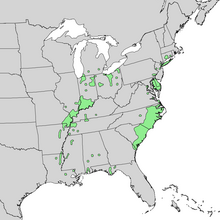|
Populus heterophylla
Populus heterophylla, also known as downy poplar,[2] swamp poplar[2] and swamp cottonwood,[3] is a large deciduous poplar belonging to the Populus genus of the family Salicaceae. This species can grow on sites that have too much water for other native poplars.[4] On the IUCN Red List this species is listed as "least concern".[5] DescriptionSwamp poplar can reach a height 50 to 100 ft at maturity.[3] The trunk and branches are a light to medium grey, with the trunk being coarsely furrowed.[3] The leaves are alternate deciduous that are 4 to 6 inches (10 to 15 cm) long and 3 to 4 inches (7.6 to 10.2 cm) across.[3] Mature leaves are medium to dark green on their upper surface and pale green on the lower surface.[3] Petioles are 2 to 3 inches (5.1 to 7.6 cm) long and tend to be between pale green and pale yellow.[3] This species is pollinated by wind.[4] This species flowers in April and fruits May-June.[2] HabitatLocationThis species is indigenous to warm, temperate regions in North America, although nowhere is it considered abundant. It is found in wet bottomland forests.[4] Swamp cottonwood can be found along the east coast of the United States from Connecticut to Georgia, as well as northwestern Florida and west to Louisiana.[4] It also grows in the Mississippi valley, Ohio and southern Michigan.[4] Soils and topographyPopulus heterophylla is typically found on heavy clays, but can be found on the edges of swamps (not within).[4] Ideal growth will happen in areas where the water table is near the surface for all but two to three months a year.[4] ClimateHumid climate is common throughout the range of the swamp poplar.[4] Rainfall varies for this species based on how far north it is found. When found in Indiana the average annual rainfall is about 35 in (890 cm); as opposed to when found in Louisiana average annual rainfall is 59 in (1500 mm).[4] Yearly average temperatures range in the North and South from 50°F to 70°F respectively.[4] Special usesThere are no special uses or commercial value for this species due to the similarity to Populus deltoides, which grows faster and easier.[citation needed] References
External links |
||||||||||||||||||||||||||||||||||||
Portal di Ensiklopedia Dunia


